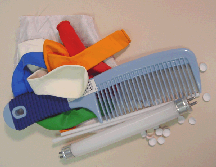BACKGROUND:
 Electricity is
produced when an electron moves after being taken away from an atom.
Review that atoms make up all matter. Atoms are usually electrically
balanced, there are as many positive charges (protons) as there are
negative charges (electrons). Particles with the same charge repel or
push each other apart. Electrons repel electrons; protons repel protons.
Particles with the opposite charges attract each other. However, when
the electrons leave and move together it produces electricity. When this
electricity is controlled, it is called current electricity, when it
can't be controlled it is called static electricity. Electricity is
produced when an electron moves after being taken away from an atom.
Review that atoms make up all matter. Atoms are usually electrically
balanced, there are as many positive charges (protons) as there are
negative charges (electrons). Particles with the same charge repel or
push each other apart. Electrons repel electrons; protons repel protons.
Particles with the opposite charges attract each other. However, when
the electrons leave and move together it produces electricity. When this
electricity is controlled, it is called current electricity, when it
can't be controlled it is called static electricity.
In the cartoon to the
left, the "scientist" is chasing an escaped electron from an
atom. That electron creates energy that we refer to as electricity.
Electrons are easy to remove from an atom, unlike protons and neutrons. PROCEDURE:
- In lab, students will experience static
electricity. On damp days, static electricity sometimes doesn't do
what it is suppose to. The best days are when it is warm and dry.
Make sure to follow the instructions on the sheet. The best type of
cloth to use is wool or nylon. To explore more with your students,
find out which cloth has the most "static" by rubbing different
types of cloths on the comb and see which one is the quickest to
pick up the confetti.
-
 Have students blow up the balloon. Direct
them to put the balloon on the wall. The more the students rub the
balloon, the longer it will stay on the wall. This activity can be
extended by having students use different types of cloth. Have students blow up the balloon. Direct
them to put the balloon on the wall. The more the students rub the
balloon, the longer it will stay on the wall. This activity can be
extended by having students use different types of cloth.
- Students should also rub the balloon and put
a fluorescent tube end on the balloon. Rub the balloon rapidly and
then barely touch the side of the tube to the balloon. Do this
rapidly. If enough static electricity is built up, the electrons
will go through the tube and allow it to glow. Darken the room so
students can see this better. They will become very excited about
the bulb glowing. It sometimes takes many attempts for this to work.
|